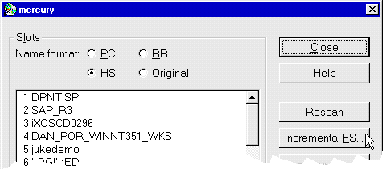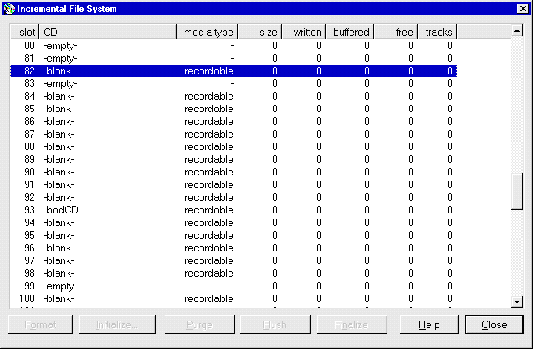
Select [CONTENTS]:

Select [INCREMENTAL FS...]:

At least one separate recorder or a recorder in a jukebox enabled for IFS is
needed to use the incremental file system. Alternatively, to test the
functionality a hard disk image can be used (see "Disk images on hard disk" on
page 220).
Format disk
Click [FORMAT]. Formatting of a disk may take some time.
Initialize disk
The disk needs to be initialized before files can be actually written to it.
Writeable disks appear as -badCD- or -blank- in the list,
deppending of the recorder. Select the disk to be initialized and click
[INITIALIZE...]. You will be asked for the disk label, and the disk is
initialized using this name.
Once the disk is initialized files can be copied to it. Everything written to
the disk is stored in the IFS buffer first.
Write buffered data
Click [FLUSH] to actually write the buffered data to disk. This will
write an additional track to the disk.
Two tracks are already used when the disk is initialized. One more track is
required for the table of contents when finalizing the disk. Up to 96 tracks
can be written to a CD-R, since a CD-R is limited to 99 tracks. There is no
limitation to the number of tracks for PDs, WORMs, MOs, and hard disk images.
Please note that iXOS-JUKEMAN does not check if sufficient space is provided on
the disk to write the final contents track.
Delete buffered data
Select the disk for which the buffered data should be deleted and click
[PURGE].
Finalize disk
Click [FINALIZE] when no further data shall be written to the disk.
The disk is converted to the ISO 9660 standard level 1. It can be read in any
drive, even without iXOS-JUKEMAN.
Test disk
If the disk is finished using finalize the disk can be made visible in
the file system by testing it. See "Test disks" on page 118.
Initialize disk
cdadm writer fsi=ifs action=init location=jb.dev,27 vname=vol
This command initializes the CD-R in slot 27 of device jb.dev using
the name "vol". Once the disk is initialized files can be copied to
it. Everything written to the disk is stored in the IFS buffer first.
Write buffered data
To actually write the buffered data to the disk issue the command:
cdadm writer action=flush vname=vol
This will write an additional track to the disk.
Two tracks are already used when the disk is initialized. One more track is
required for the table of contents when finalizing the disk. Up to 96 tracks
can be written to a CD-R, since a CD-R is limited to 99 tracks. There is no
limitation to the number of tracks for PDs, WORMs, MOs, and hard disk images.
Please note that iXOS-JUKEMAN does not check if sufficient space is provided on
the disk to write the final contents track.
Verify written data
The last written track can be verified with the command:
cdadm writer action=verify vname=vol
You can also specify the options track=<number> or
track=all to verify track number <number> or all tracks.
Finalize disk
The disk can be finalized with the following command:
cdadm writer action=finalize vname=vol
The disk is converted to ISO 9660.
Test disk
To make the finalized disk visible in the file system, issue the following
command:
cdadm testcd jb.dev 27
This instructs iXOS-JUKEMAN, to test the CD in slot 27 and add it to the file system.